13. "THE GREAT WAR" (WORLD WAR ONE)

WAR CLOUDS GATHER
CONTENTS
 The path to world war The path to world war
 Tsar Nicholas II's Russia Tsar Nicholas II's Russia
 Ottoman Turkey Ottoman Turkey
 The Balkan Wars as prelude to the The Balkan Wars as prelude to the
coming "Great War"
 Growing tensions among the majo Growing tensions among the majo
European powers
 War fever refuses to cool down War fever refuses to cool down
The textual material on page below is drawn directly from my work
A Moral History of Western Society © 2024, Volume Two, pages 67-78.
By
the opening days of the twentieth century the Europeans and Americans
had clearly put the political-cultural stamp of the Christian West on
most of the rest of the world. This would mark the peak of
Western glory. It would also mark the beginning of its
political-cultural decline ... at least with respect to Europe’s part
in the Western political-cultural dynamic.
Ironically it was the very sense of Western "progressivism" that would
be its undoing. The rising theory of the "sovereignty of the
people" – as opposed to the sovereignty of their traditional lords
(kings and emperors) – sounded so noble, so progressive. But it
contained a set of social dynamics that no one seemed able either to
understand or manage when set loose. Thus the first half of
the twentieth century would be marked by not only levels of violence
not seen in centuries, it would also bring the decline in global
influence of those very groups who thought themselves to be the
teachers of "good citizenship" and "proper civilization" to the rest of
the world.
In the earlier days of the recognized importance of kings and emperors
as the glue bonding numerous societies into a single whole, offering
stability and peace for the common people in the process, kingdoms and
empires made a great deal of political sense. They could unite
the most varied of people ... even ones who otherwise would be at each
other’s throats because of more local hatreds possessing deep
historical roots. Thus just as the Austro-Hungarian Empire held
together Germans, Hungarians, Poles, Bohemians (Czechs), Moravians,
Ruthenians, etc. with Lutheran, Calvinist, Catholic, Orthodox religious
self-identities as well ... the Ottoman Empire united Turks, Arabs,
Greeks, Armenians, Bulgarians, etc., also of a wide religious variety
as Sunni, Shi’ite, Druze and Alawi Muslims and Catholic, Orthodox and
Coptic Christians.
The problems of tribal "group-think" or "nationalism."
Now with the arrival of the "Age of Nationalism," each of these smaller
ethnic/religious sub-groups was expected to define, defend and promote
its own "national" identity … a task muddied greatly by the fact that
there were no clear geographic borders separating these sub-groups into
distinct national packages. While there were certainly points of
concentration on the map for one or another of these sub-groups, they
found themselves scattered amidst other sub-groups as you moved outward
from these central points. Just trying to draw national
boundaries among these subgroups was guaranteed to pit one group
violently against another (or even several others!)
Furthermore, a kind of nationalist "Romanticism" had turned the very
idea of the nation itself into a highly revered, even worshiped, object
of social affection ("group think") … something not really allowable
during the previous centuries of dynastic rule in the West. But
with the rise of the political urges of the masses – birthed by
Napoleon and his "nationalist" armies in the early 1800s – dynastic
governments now found themselves on a steady political retreat in
Europe. The dynasties that continued in place no longer
represented merely their own family interests … but were there to
cultivate this larger group-think, to bring the people they presided
over to ever-grander political purpose. But these dynasties –
untrained in the ways of popular democracy – possessed very little
understanding, and in some cases no understanding at all, of the forces
they were unleashing in their efforts to govern their increasingly
nationalistic societies. Thus it was that the forces of
nationalism constituted a powder keg waiting to explode.
Tragically the utopian idealists and nationalist dreamers were
completely self-blinded on this subject (as they still are
today). The theory of "the self-determination of peoples
everywhere" sounded so noble … especially to intellectuals far removed
from the practical difficulties found in the realm of political
actuality.
The basic requirements of social success.
Self-government of a people is a great idea … provided that the people
themselves have a well-practiced habit of moral self-discipline, a
habit built on the foundations of a well-supported system of laws and
social boundaries … ones that have proven themselves through the test
of time. Trendy, and thus untested, political ideas and ideals
must always be viewed with much caution.
The people must also possess a spirit of social compromise based on the
understanding that they must first look to the larger challenges facing
them collectively as a people … rather than get caught up with more
immediate local matters, ones that so much more easily draw their
attention and arouse their emotions.
And political wisdom demands that this sense of collective challenge
must not just stop at the national border … but extend to other people
groups, other societies, other tribes and nations besides their
own. Working with others not only amplifies the social power
available to a people to work with, it also tends to broaden a people's
sense of political self-interest to a much higher realm – the lofty but
complex realm of international politics
.
The massive tragedy that was about to hit Europe – and bring its days
as the world's power center into rapid decline – happened because this
same wisdom, this vital realism, was lacking in Europe's various
nations … and especially in their leadership.
Indeed, excellent leadership is critical to a society trying to live to
higher social standards. But finding such leadership is always a
serious challenge facing any society.
To be a great leader, a person must possess not only a great intellect but also a deep wisdom
… a wisdom achieved through excellent early education, through the
careful attention paid to earlier generations of a life of proven
success, and then through considerable personal experience in seeing
all those learned lessons of life put to the test.
But also to be a great leader, a person must possess a high degree of personal ambition,
one able to keep a person going in the not-uncommon face of grand
disappointments – even failures – in the early effort to find success …
and then in success, the ability not to give in to a reactive
opposition that success naturally provokes in the hearts of other
equally-ambitious competitors.
Thus importantly, it requires both wisdom and ambition to produce a
great leader. But on the one hand, there are always wise ones in
society who (maybe most wisely itself!) choose not to get involved in
the rough-and-tumble game of politics. And on the other hand,
there are always the very ambitious – but not so wise – ones … ones who
are so caught up in their own personal success that they possess none
of the greater wisdom that society will need in facing its
challenges. Tragically it is exactly this latter group that can
actually bring a society to defeat, even to collapse.
So … coming up with a great leader is not a matter easily secured for a society.
The challenges facing Western society at this point.
As it enters the twentieth century, the Western world will find itself
facing exactly this very challenge. Indeed, lacking tested
leadership in the newly rising world of "democracy," the move to
self-government will become a formula for a savage breakdown in the
European social order – in which thousands, hundreds of thousands, even
millions of ordinary people will get sacrificed to the gods of rising
nationalism.
But it was not just dreamy "Progressivists" who were guilty of shaping
this terrible social disaster. It was also kings and emperors
themselves who did not understand what was going on right under their
noses, and so managed to do the worst of things at the worst of
moments, activity well designed to make a complicated situation
virtually unmanageable, and ultimately catastrophic.
Some leaders seemed particularly expert in this regard. Chief
among them was Nicholas II of Russia (r. 1894-1917), who had virtually
no understanding of the mentality of the Russian peasants he was
reigning over.
There was also Franz Joseph, the Austro-Hungarian emperor, who though a
man of some intelligence, was nonetheless in over his head leading an
empire made up of a multitude of contending national groups, groups
that had few political interests in common. And sadly, Franz
Joseph’s Austria-Hungary was not content in possessing this
unmanageable bag of contending nationalities. Austria-Hungary
seemed determined to acquire even additional national groups, such as
the Serbs, just to the south of the Austrian-Hungarian border.
Serbs, of course, had other thoughts on this matter, especially the
hyper-nationalists among them.
In fact it would be this very problem brewing between the Austrians and
the Serbs that would finally set off the fires of war, which once
ignited, seemingly could not be put out. And so a pointless
bloodletting ensued, dragging itself out for four whole years.
Finally America brought new blood into the exhausted mix, breaking the
deadlock and tipping the balance of power in favor of one side over the
other, bringing the war finally to an equally pointless end.
Tragically the war would cripple the participants so badly that Europe,
even in the period of post-war "peace," would be unable to reclaim its
former position of world influence. The decline of Europe thus
got itself underway.
TSAR NICHOLAS II'S RUSSIA |
|
The Russo-Japanese War (1904-1905)
In its push to acquire additional territory, Russia had been reaching
eastward across Asia for decades and had arrived at the Pacific Ocean
by the mid-1600s. Over the next two centuries migrating into
Siberia were Russian fur traders, Cossacks, exiled criminals and
farmers escaping serfdom and looking for inexpensive land.
Resistance of the previous inhabitants, small nomadic communities
mostly, was problematic but not unsurmountable. So was the
resistance this Russian expansion drew from the Chinese emperor (who at
the time was hard pressed by the Taiping Rebellion and the Opium War
with Britain) resulting in the 1860 Treaty of Aigun, which favored
Russian claims in Manchuria.
But the biggest difficulty facing Russia would come from the Japanese,
who also had imperial interests in the same area. Under the
direction of the Japanese emperor, Japan had been both industrializing
and militarizing, using the very latest technology (acquired mostly
from Bismarck’s Germany) in the process. Their achievements were
stupendous ... very unexpected of a people who were not "White."
The Europeans would be startled by the readiness of the Japanese to
join them in putting down the Chinese Boxer Rebellion ... the Japanese
showing themselves to be as capable as any of the European powers in
their own imperial conduct.
Since the Vladivostok port on the Pacific was usable only during the
summer, the Russians had contracted with the Chinese the use of a port
(Port Arthur) further to the south in the Liaodong Province. This
brought them up against the Japanese who were interested in the same
region. The Japanese proposed an agreement in which Russia would
recognize Japanese control of Korea in return for Japan recognizing
Russian dominance in Manchuria. But discussions went nowhere
(meanwhile the Russians were building up their forces in the region).
Finally, in May of 1904 the Japanese conducted a surprise attack on –
and a blockade of – the Russian position at Port Arthur – and also
moved troops into Korea, taking that land for their own Japanese
empire. Bombardment of the Russians at Port Arthur continued
through the rest of the year, the Russians unable to break the
siege. Then much to the surprise of everyone (including the
Russians) at the beginning of January 1905, the Russian commander at
Port Arthur simply surrendered to the Japanese. Then in February
both sides (a total of 500 thousand men) met at Mukden, and after three
weeks of fighting the Russians abandoned their position there.
Finally, the Russian Baltic Fleet arrived in the area and at the
straits of Tsushima (the narrows between Korea and Japan) the two
navies met in late May ... again with disastrous results for the
exhausted Russian navy. The Russians were now ready to quit.
American President Teddy Roosevelt hosted a peace conference in
Portsmouth, New Hampshire (September 1905), in which the Russians got
off with only the loss of their positions at Port Arthur and on the
southern half of the Sakhalin Island. But the Russian humiliation
cut deeply nonetheless.
|
The Russo-Japanese War (1904
- 1905)
A modernized Japan challenged
Russia to battle – and Russia lost
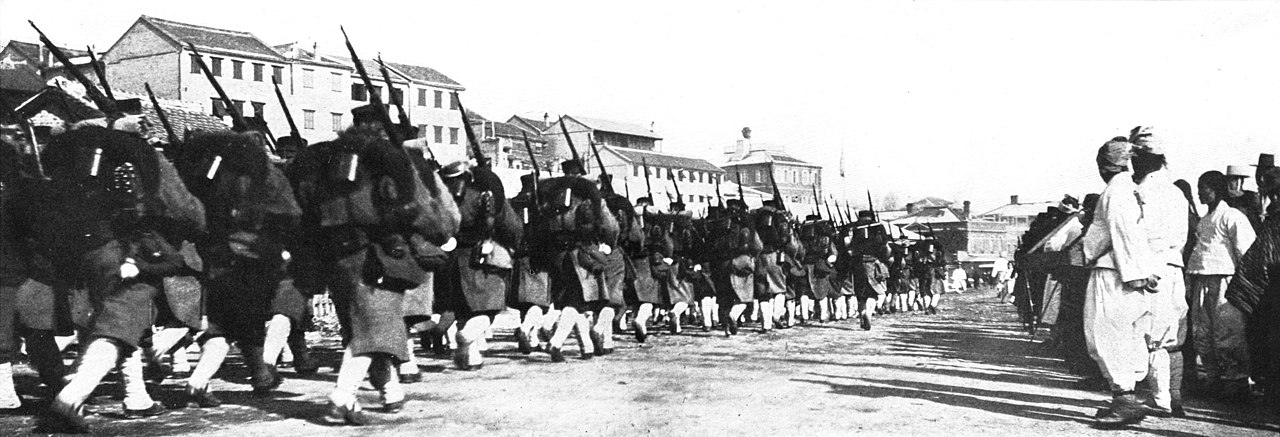
Japanese troops marching through Seoul Korea - 1904

Japanese troops in
Manchuria - 1904
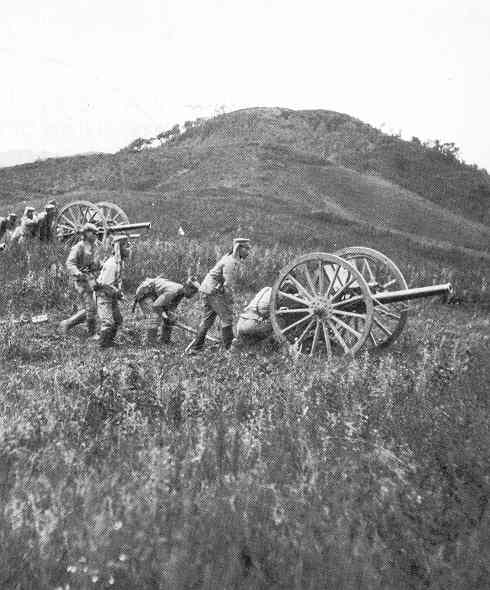 Japanese cannon during the
Russo-Japanese War of 1904-1905
Japanese cannon during the
Russo-Japanese War of 1904-1905
National Archives
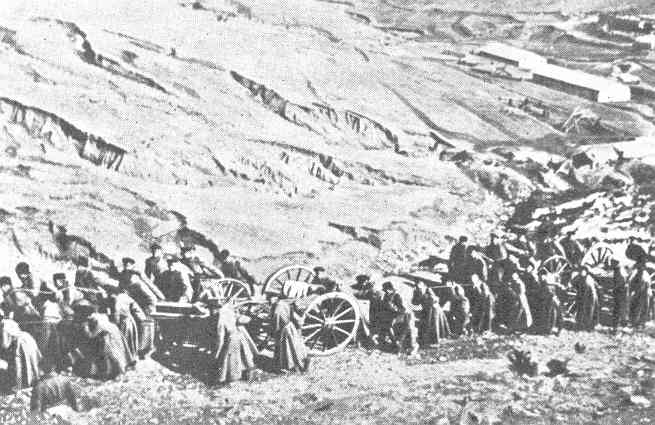
Russians moving artillery
during the Russo-Japanese War
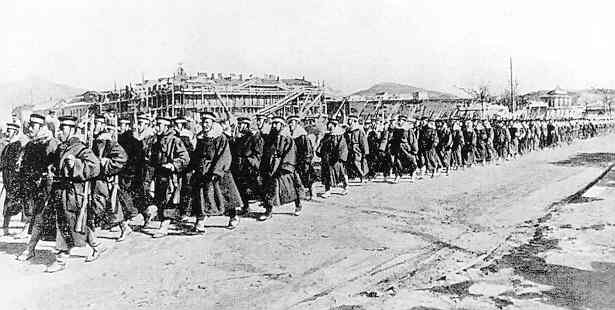 Japanese entering Port
Arthur
Japanese entering Port
Arthur
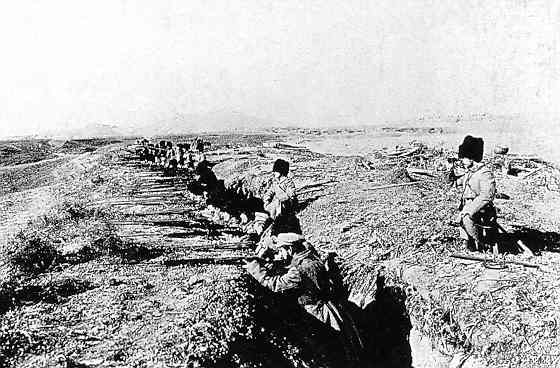
Russian trenches at the Battle
of Mukden (February 20 - March 10, 1905)
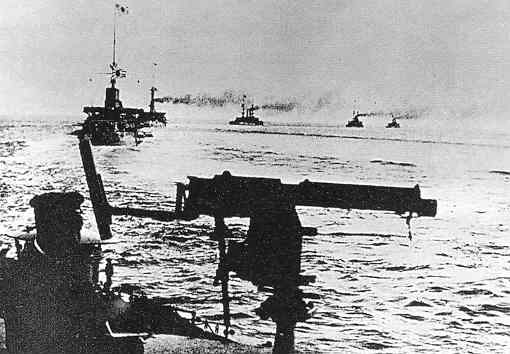
Japanese warships steaming
toward Tsushima to intercept the Russian fleet
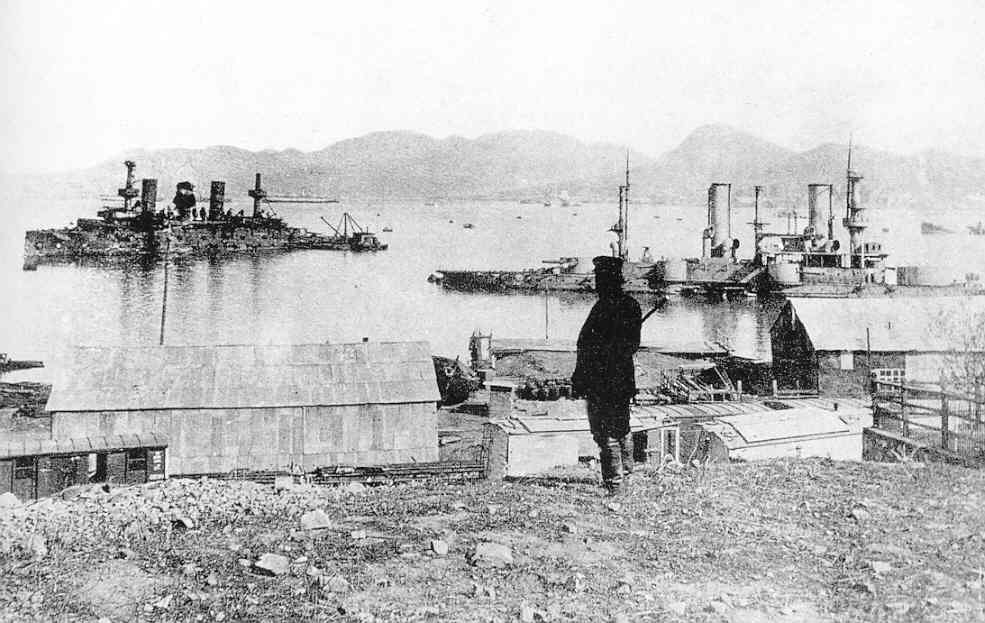
Russian ships sunk at
Tsushima

Roosevelt meeting with the Russian and Japanese envoys
to negotiate the Portsmouth Treaty - 1905
|
The Russian Revolution of 1905
The timing of the conflict with the Japanese could not have come at a
worse time. Social agitation back in Russia had been building
since even before the war over the sense of gross mistreatment of the
Russian industrial worker by the new industrial lords. At the
same time these new industrial owners had been agitating for liberal
constitutional reforms. Thus labor unions had been organizing as
fast as liberal revolutionary societies ... all pressing for serious
overhaul of the Russian social and political system.
The Tsar however seemed unable to gauge the seriousness of this
agitation ... presuming that simple police action would suffice to keep
such radical tendencies in check. When in early 1905 a peaceful
demonstration led by a Russian priest and involving about 50 thousand
men and women in St. Petersburg was met by the Tsar’s soldiers who
killed hundreds and wounded over a thousand demonstrators (Bloody
Sunday) Russia exploded. Russia seemed to be spinning out of
control.
Workers’ councils (soviets) appeared everywhere and
liberals grew louder in their demand for reform. In October
(after the humiliating Portsmouth Treaty was signed with the Japanese)
a general strike was held across the country ... virtually shutting
down the entire Russian economy. The army had to be called out and was
put to work crushing brutally the protest movement. The Tsar
ultimately responded (the October Manifesto) by promising a number of
civil rights reforms ... and by offering a new Constitution and creating a Duma (legislature), so
eagerly sought by the liberal reformers. For the time being
things settled down.
But pro-labor agitators (this included Lenin, who returned from Geneva for the occasion) saw
this backing down of the Tsar as a great opportunity to push for
Socialist reforms ... and scheduled a massive revolt for early
December. But despite the huge turnout of workers and their
soviet leaders to build street barricades in protest against the
government, they were met by soldiers who blasted the positions of the
protestors. Ultimately the workers' uprising failed ... and the
organizers decided to call off the protest. But feelings still
ran deep.
In 1906 the First Duma met in St. Petersburg ... but found the Tsar
highly reactive to pleas for deeper reform. To protect the almost sacred legacy of "autocracy," he instead reduced
the few rights of the Duma even further ... and then simply dismissed
the body. The next year (1907) the Duma again met, proving to be
even more hostile to the Tsar. It too was soon dissolved.
But before a Third Duma could meet the Tsar reshaped it so that it
represented only the more conservative members of the upper middle
class.
Serious reform would have to wait. As for the Tsar’s promised
civil rights reforms, those simply got dropped. Police repression
continued as it had before.
|
Bloody Sunday - January 1905 starts the rebellion
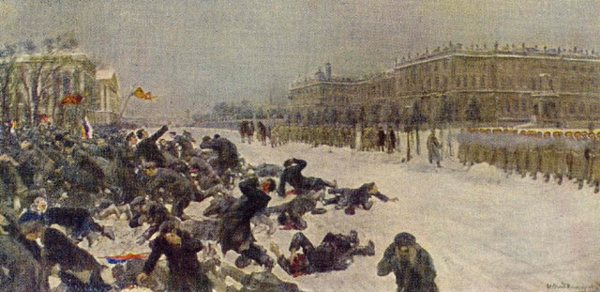
Soldiers firing on a huge crowd of Russians who had come to deliver a petiton to the Tsar.
Hundreds are killed (no one is sure of the actual number).
This action merely inspired more protesting throughout Russia
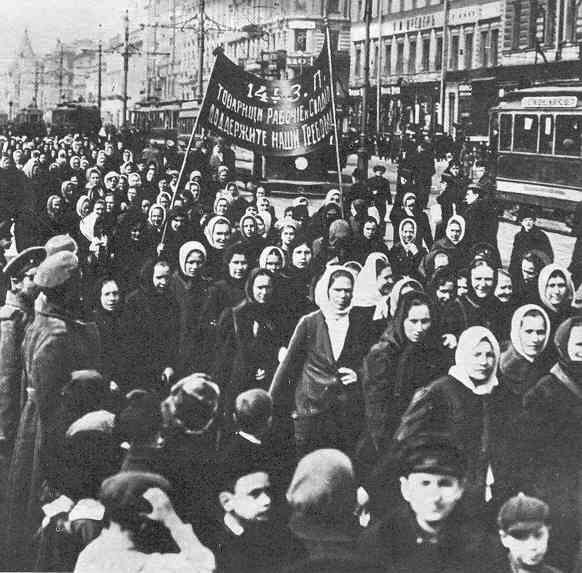
"Comrades, Workers and Soldiers
- Support Our Demands"
Women marching for governmental
reform as the protest movement gains strength
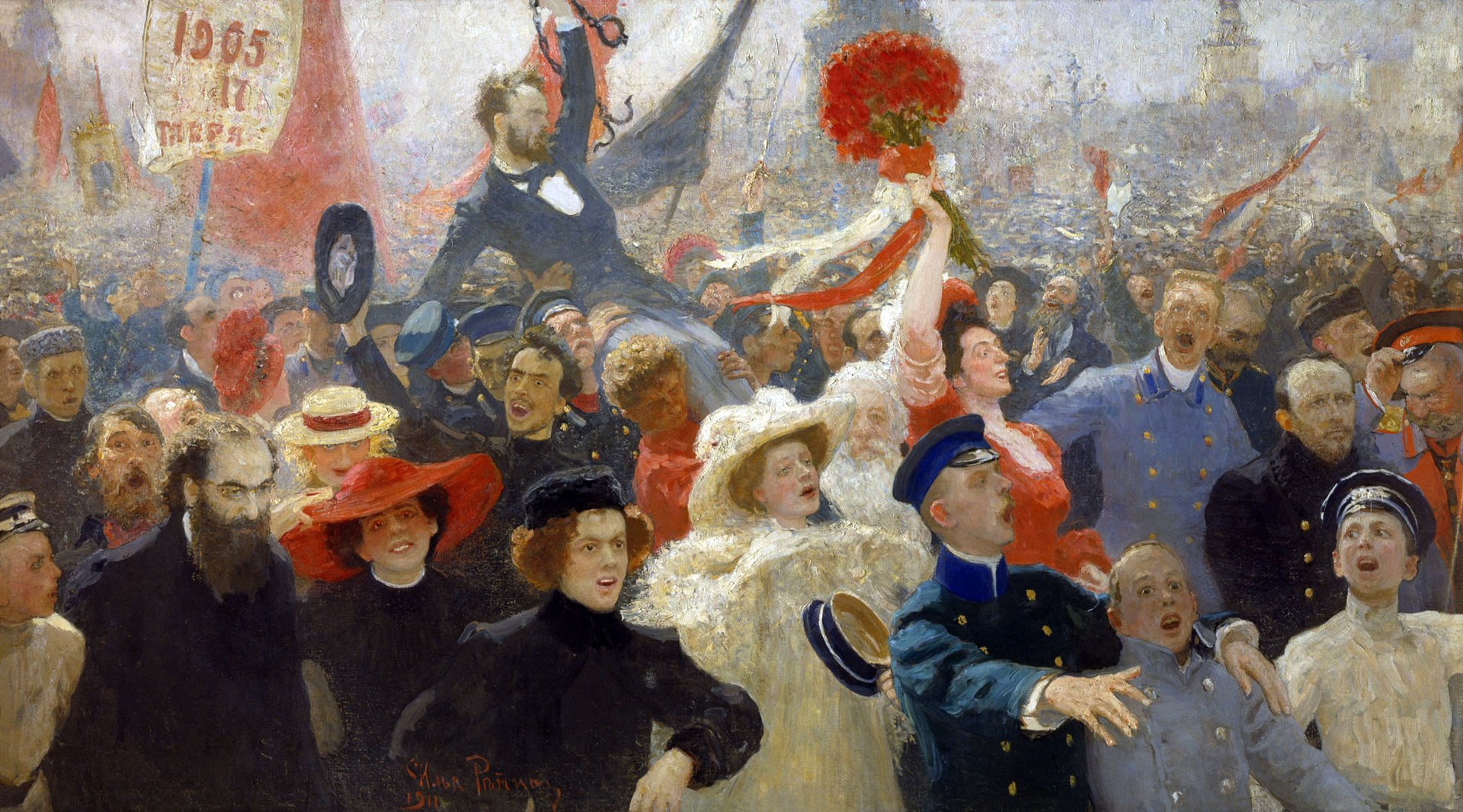
Russians celebrating Nicholas's October Manifesto (1905), leading to a new Constitution (1906)
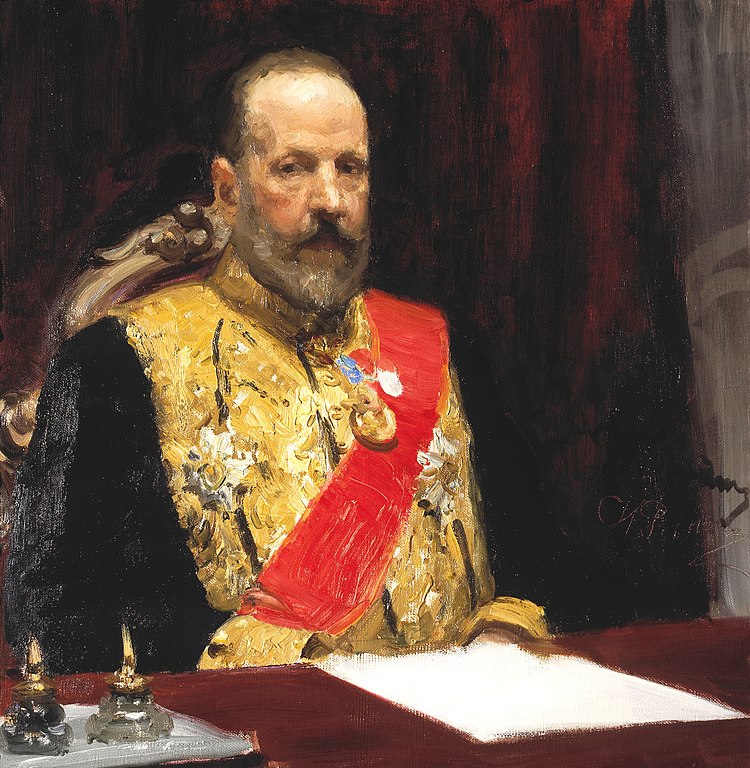
Sergei Witte - by Ilya Repin, the Emperor's prime minister (1903-1906) who helped shape the 1906 constitution. Also Finance Minister (1892-1903) - helping design Russia's entry into the industrial world
Tretyakov Gallery - Moscow
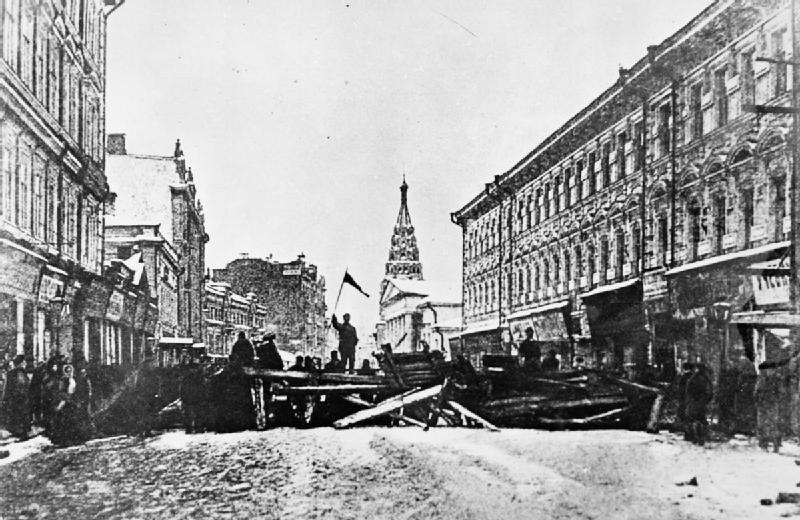 An industrial workers' street barricade in Moscow - December 1905
An industrial workers' street barricade in Moscow - December 1905
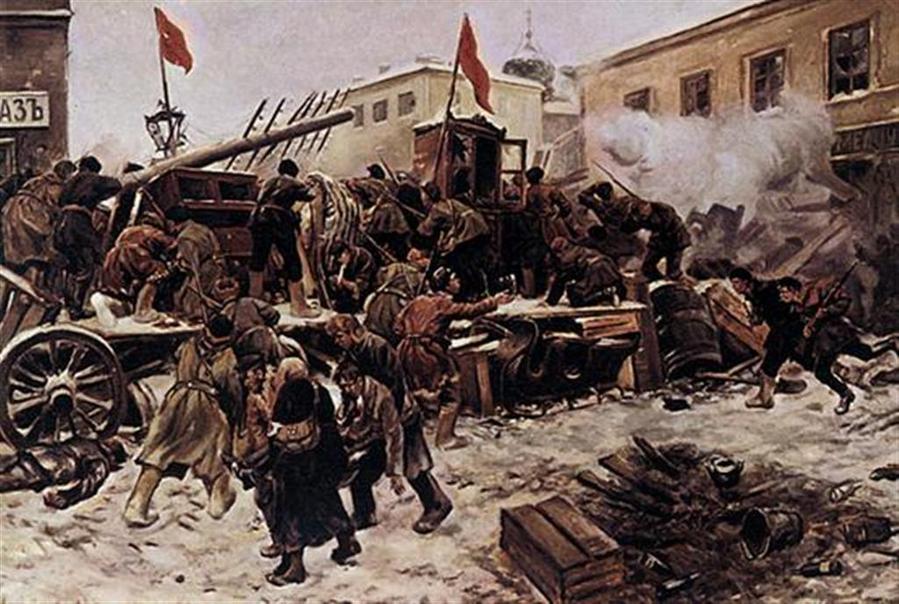 Russian protest in Moscow in early December of 1905
Russian protest in Moscow in early December of 1905
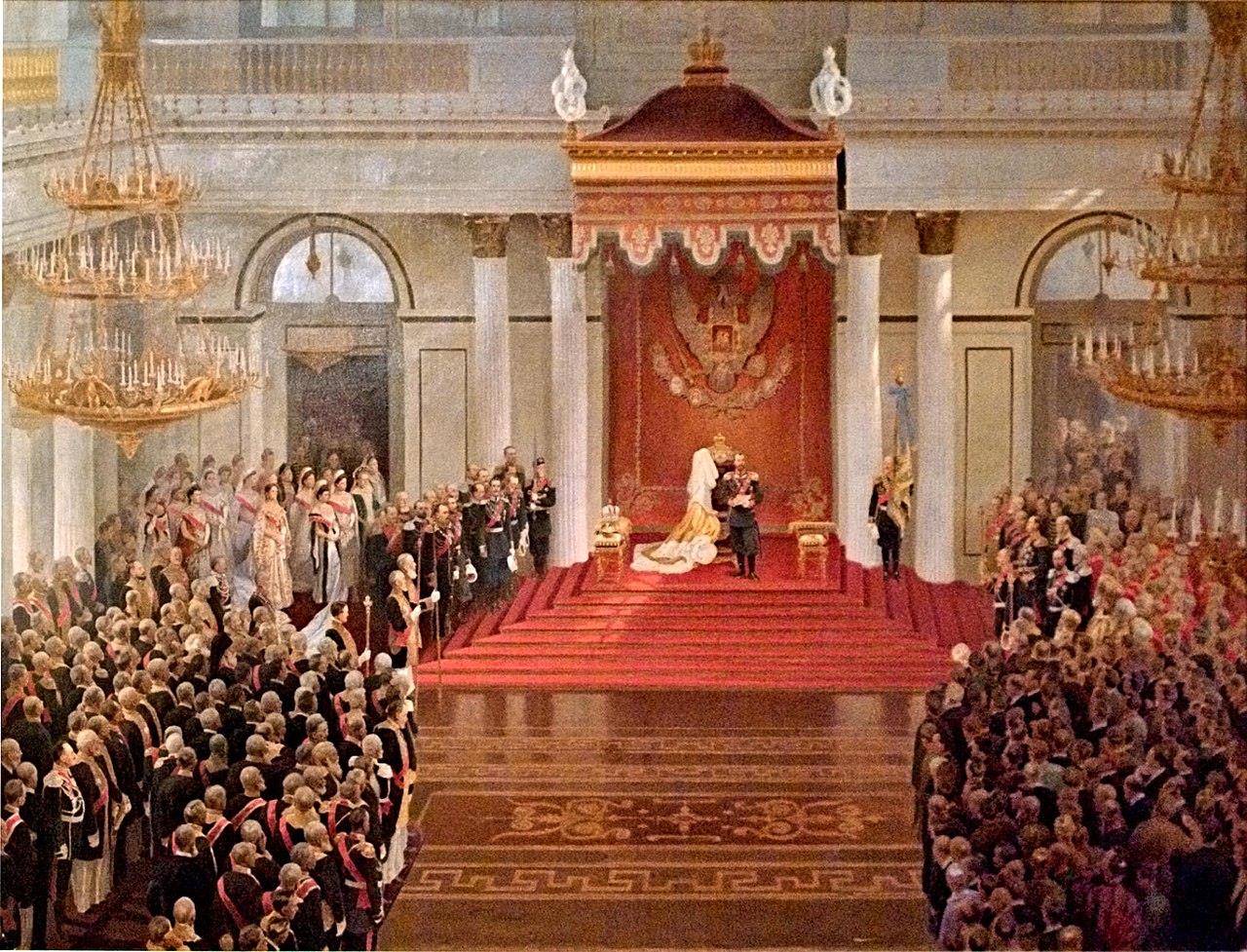
Nicholas II and the Russian
Duma - April 1906
|
The Rasputin scandal
Clearly, the imperial family was losing touch with reality.
Tragedy stalked the halls of the Tsar’s Winter Palace. Adding to
the tragedy was the scandal created by the presence of the mysterious
Russian holy-man Grigori Efimovich Rasputin, who in 1907 had worked his
way into the imperial household on the claim that he had mystical
powers to heal the young prince Alexei, who suffered from the incurable
illness hemophilia (no ability to stop bleeding when injured).
Soon Rasputin became a regular celebrity within the imperial circle,
complements of the Tsarina, who was completely convinced of his divine
powers. Being a very hard-headed woman, she would also hear of
none of the rising complaints about how Rasputin’s frequent presence in
the imperial court was causing highly damaging rumors to spread wildly
among the Russian people.
Little by little opposition to him began to brew within the imperial
court. Yet as time went on, Rasputin – with the support of the
Tsarina Alexandra – seemed to grow in influence in the matters of state
... especially with the departure in August of 1915 of the Tsar for the
front during the "Great War" (World War One, which had been underway
since August of 1914).
Resentment among the men of the imperial court grew so great that
finally in January 1916 a small group of them plotted his murder ...
which proved not to be as easy as they had hoped (or so the legend
goes). But indeed finally he was gone. But by this time the
Great War was giving Russia even bigger issues than Rasputin. |
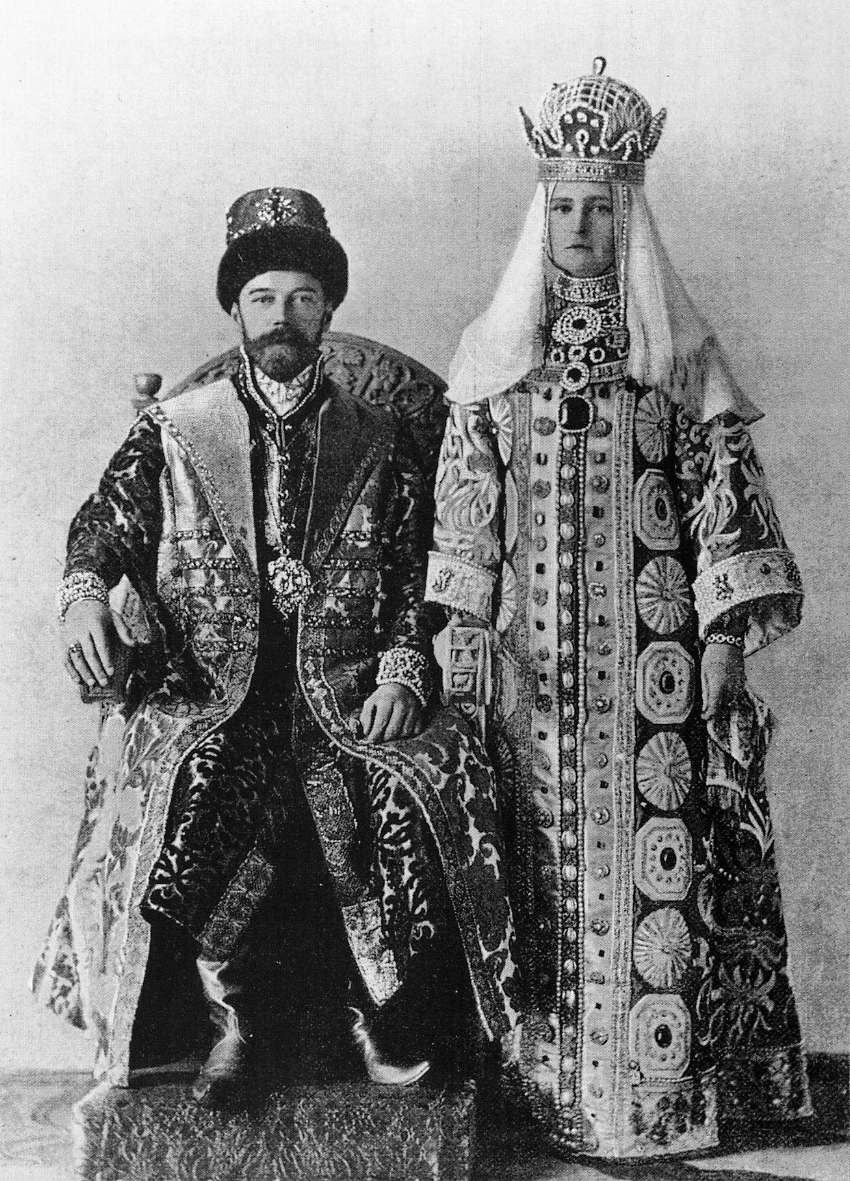
Nicholas and Alexandra
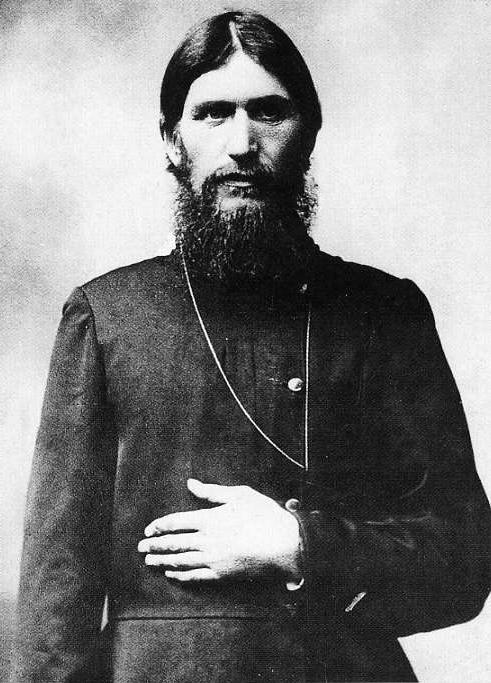 Grigori Rasputin - mystical
adviser to the Tsarina
Grigori Rasputin - mystical
adviser to the Tsarina
(the seedier side of imperial
culture)
|
The Young Turks
With the power of the Turkish sultanate fading away, the Young Ottomans
formed and reformed their secret political organizations, adding
medical students and military officers to their rolls. They
eventually created a political union, the Committee of Union and
Progress (CUP) which in 1902 and 1907 held its first and second
congresses (in France).
Then in 1908 the military wing, beginning to be termed the "Young
Turks" – under the leadership of "the three pashas" (Talaat Pasha,
Enver Pasha, and Djemal Pasha) – marched on the capital at
Constantinople (Istanbul) and forced the sultan to restore the
Constitution of 1876. While he agreed, he seemed to be
encouraging reactionary elements in the military, who in 1909 attempted
a counter-revolution against the Young Turks. The effort failed,
and Abdül Hamid was forced to abdicate and go into exile. His
brother, Mehmed V, was installed as sultan in his place. But
Mehmed had no real power of his own. At this point the Young
Turks were the actual governors of the decaying Ottoman Empire.
|
The one ugly spot in the
cultural picture is the decaying Ottoman dynasty in Turkey. But a group of "Young Turks"
(mostly military) are planning to take control and bring Turkey up-to-date
through a process of "modernization" (mostly following Prussian
Germany's lead)
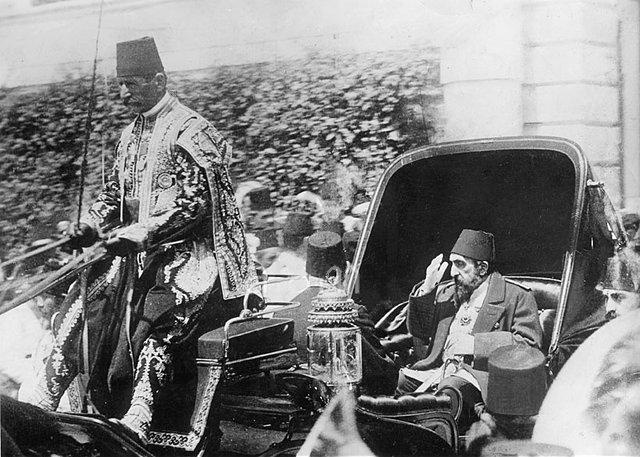 Abdul Hamid II - Ottoman
(Turkish) Sultan - 1876-1909
Abdul Hamid II - Ottoman
(Turkish) Sultan - 1876-1909
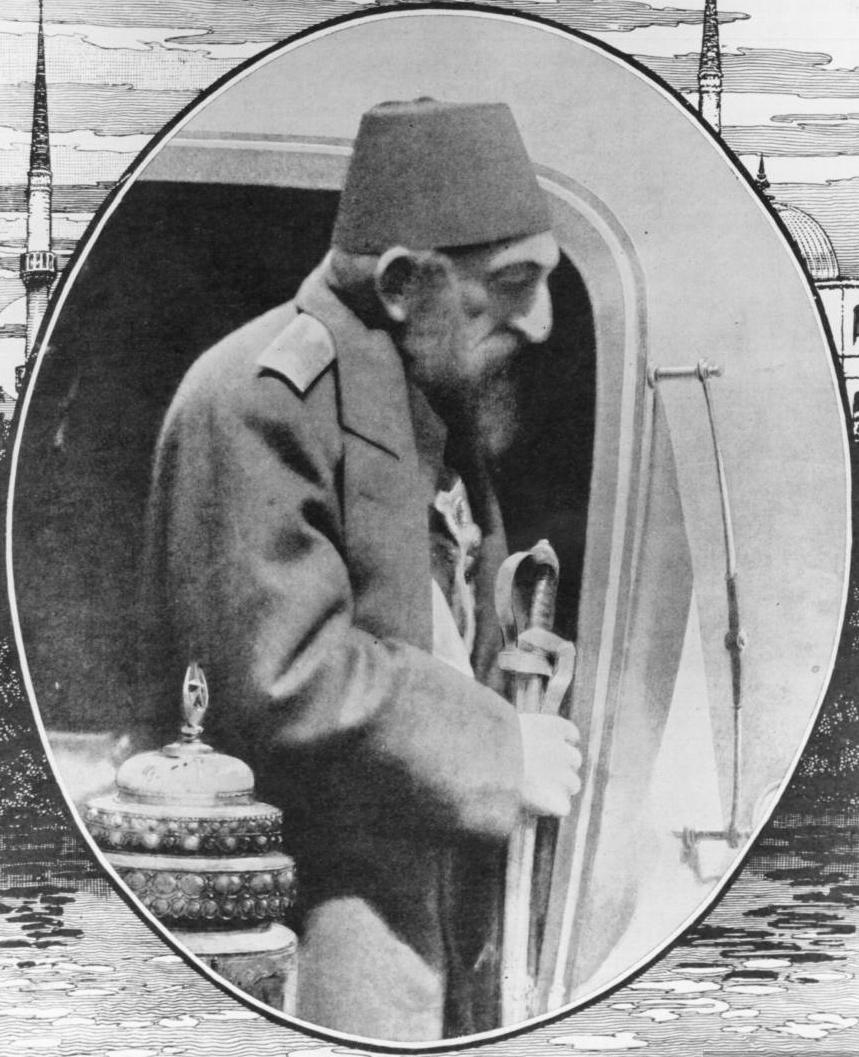 An elderly Abdul Hamid
II
An elderly Abdul Hamid
II
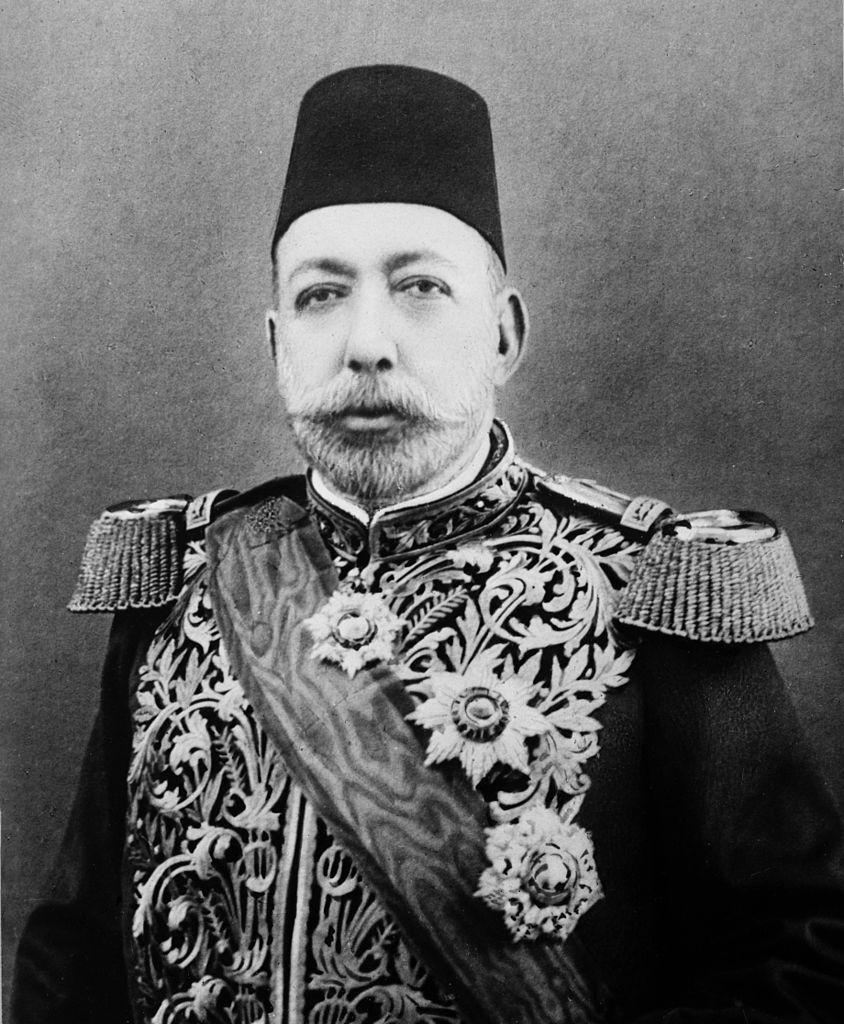
Mohammed (Mehmed) V - Ottoman
Sultan 1909-1918
The Young Turks
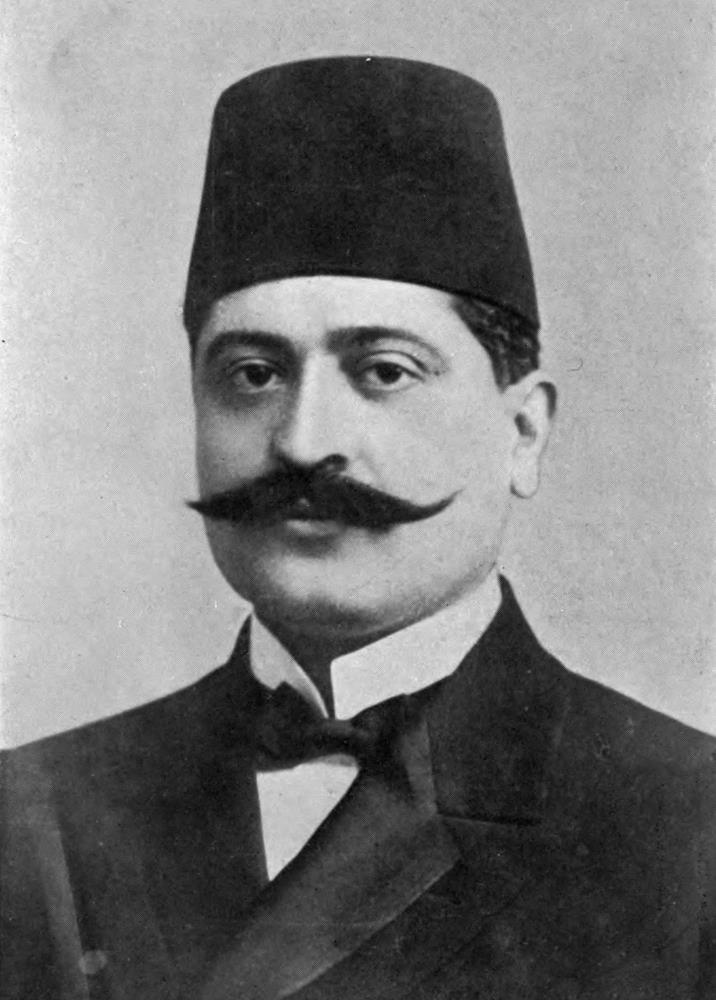
Mehmed Talaat Pasha - Minister
of the Interior (1909-1917)
Grand Vizier of the Ottoman
Empire (1917-1918)
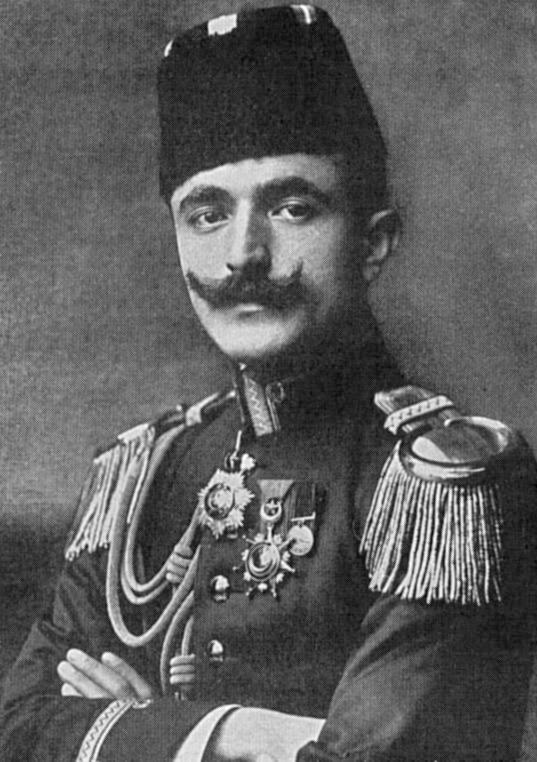
Ismail Enver Pasha - Turkish
General and Minister of War (1913-1918)
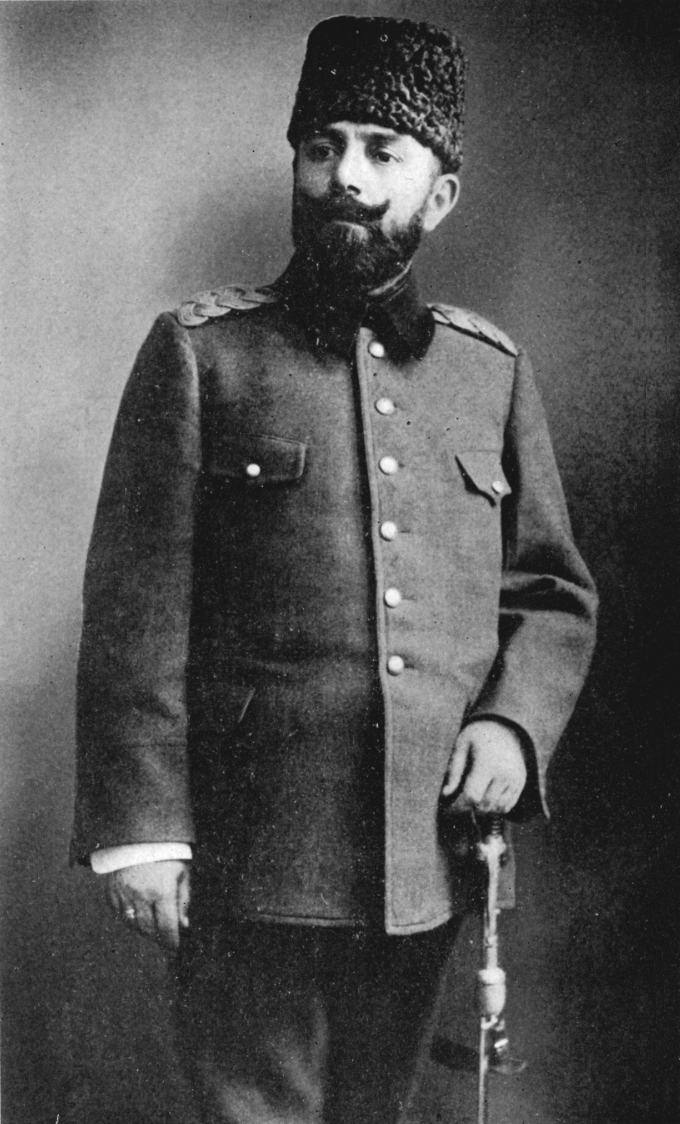
Ahmed Djemal (or Cemal)
Pasha,
Commander of Constantinople,
Minister of Public Works, Minister of the Navy and General (1913-1918).
Prominent Young Turk:
One of the "Three Pashas"
ruling the Ottoman Empire from 1913 to 1918
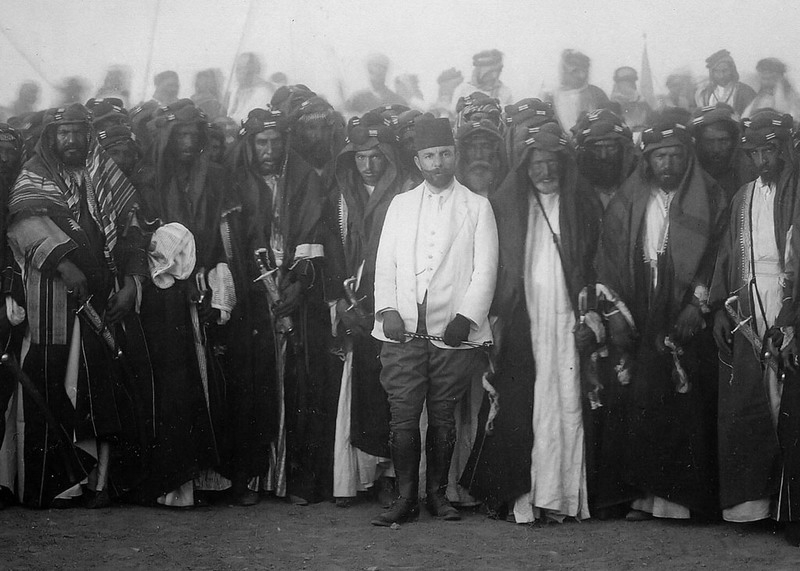
Ahmed Djemal and Arab leaders
at the completion of a dam
on the Euphrates River south of Baghdad
THE BALKAN WARS AS PRELUDE TO THE COMING "GREAT WAR" |
|
Rumania (after 1975 "Romania")
In close cooperation the Greeks, the Wallachians also rose up in revolt
against the Turks in 1821, demanding number of political reforms ...
though expressing continuing loyalty to the Sultan. Here too
infighting among the Wallachians made it relatively easy for the
Ottomans to restore Turkish order. Another attempt occurred in
1848, along with the general liberal upheavals that shook Europe that
year. This united the province of Moldavia with Wallachia to form
the idea of a united "Rumania." But the effort came to nothing
... until after the Crimean War when in 1859 electors from both
provinces voted for a single leader as Rumanian prince (within the
Ottoman Empire). In 1866 he was forced out and replaced by prince
Carol I of Rumania (of the Prussian house of Hohenzollern).
The Russo-Turkish War of 1877-1878
In 1875 peasants in
Herzegovina (just to the west of Serbia) rose up in revolt against the
heavy Turkish taxes ... and the revolt soon spread around the
Balkans. The Turks reacted violently, their slaughter being
especially heavy among the Bulgarians living just north of the
Constantinople region. This not only shocked the Europeans, it
drew the Russians into the melee as a champion of the persecuted
Bulgarians. Russian intervention no doubt was also motivated not
only by the desire to recover territories on the Black Sea lost during
the Crimean War, it was also inspired by the eternal Russian dream of
securing a foothold on the shores of the Eastern Mediterranean.
The Turks were soundly defeated. As a result, in the Treaty of
San Stefano (1878), the Turks lost sovereignty over considerable
sections of Balkan territory. Not only was Turkey forced to
acknowledge the full independence of Rumania, but also Serbia and
Montenegro.
Bulgaria
To the Russian mind, even more important was the fact that the Slavic
principality of Bulgaria (under the Bulgarian prince Ferdinand I) also
was founded as a result, stretching across the southern reaches of the
Balkan Peninsula just above Greece. But the British and the
Austro-Hungarians were afraid of such an extensive client state of
Russia and forced the replacement of the San Stefano treaty with the
Treaty of Berlin, which recognized only a smaller Bulgarian
Principality. This was designed to prevent the creation of a
strong Slavic state in the Balkans, presumably playing to the interests
of Russia ... which the other European states wanted to avoid at all
costs. The Bulgarians living in Macedonia were thus left out of
the new Bulgarian state ... a matter that would soon become the cause
of serious strife among the emerging Balkan nations.
At the same time the British were accorded the right to occupy the
strategic island of Cyprus (protecting the sea route passing nearby on
its way to the Suez Canal in Egypt) and Austria-Hungary was given the
right to "administer" the Ottoman territories of Bosnia and Herzegovina.
In theory Bulgaria was still under Ottoman authority, but it acted
rather like an independent nation. Finally in 1908 Bulgaria
declared its independence as the Kingdom of Bulgaria with Ferdinand now
designated as Bulgarian Tsar.
The Balkan Wars of 1912 and 1913
There were two conflicts that broke out in the Balkans, the first
(1912) between Turkey and a coalition of newly independent Balkan
states (the Balkan League of Bulgaria, Greece, Montenegro and Serbia),
the second (1913) a war within the community of Balkan states, pitting
Greece and Serbia against Bulgaria in a dispute about the dividing of
Macedonia as a result of the first war. Bulgaria was unhappy
about the way Greece and Serbia took the largest portions of Macedonia
... and decided to invade the area to incorporate Macedonia into
Bulgaria. Seeing Bulgaria thus distracted, Rumania – which had
stayed out of the first war – decided to launch its own offensive
against Bulgaria. And Turkey struck back at Bulgaria as
well. The end result was the dividing up of Macedonia between
Serbia and Greece, and the loss of Bulgarian territory to the Greeks,
the Turks and the Rumanians.
The major European powers had decided to stay out of the first war,
fearing that their intervention would only complicate further a
diplomatic standoff that was building among the larger powers
themselves. In the second war the major powers got indirectly involved,
though not necessarily out of a desire to do so. The net result
of this second war was the delivery of a huge blow to Russia, because
of the Russian support of Serbia – which in turn had driven its former
Bulgarian "protectorate" into the waiting hands of the Germans.
This war also further deepened the divide between Serbia and its
neighbor to the north, Austria-Hungary, which – with Germany – saw
Serbia as a new Russian dependency and a possible ally in Russia’s
quest for a forward position in the Balkans.
Tensions were building fast. It would take only a small spark to
set off a huge military conflagration. That spark was about to
occur. |
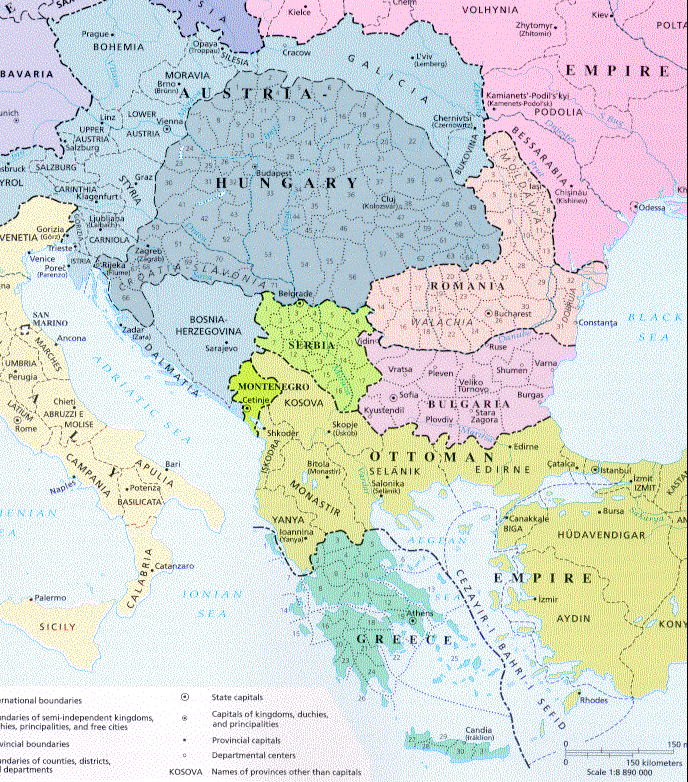
1912 - The Balkans before
the Balkan War
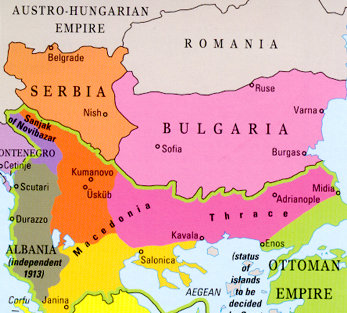 April 1913 The Balkans after
the First Balkan War
April 1913 The Balkans after
the First Balkan War
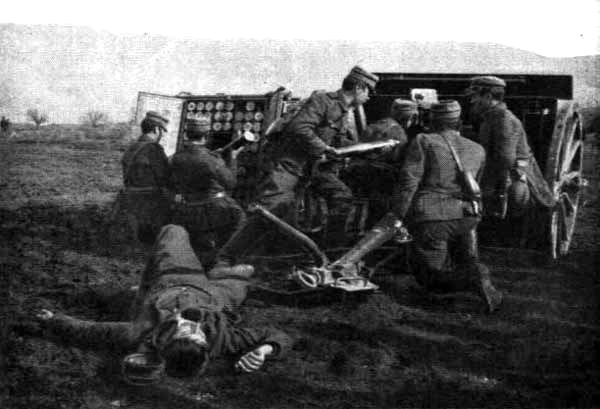
>Greek Artillery during the
Balkan Wars – 1912
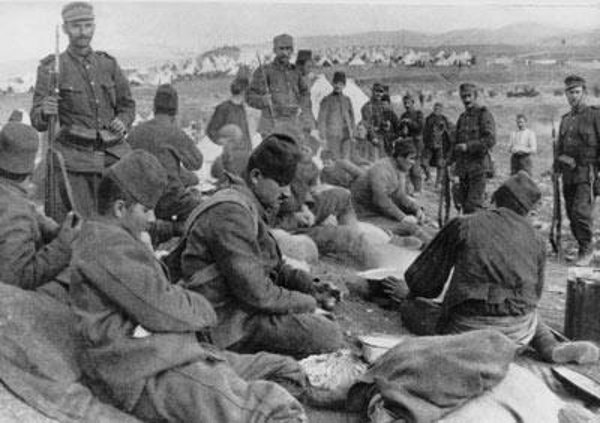 Turks captured by Greeks
at the Battle of Giannitsa – October 1912
Turks captured by Greeks
at the Battle of Giannitsa – October 1912
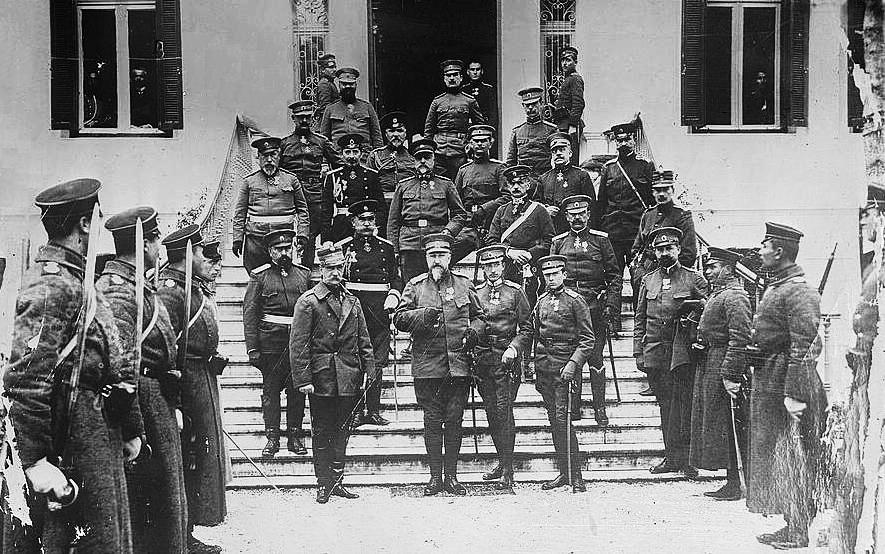
King George I of Greece visits
the Bulgarian Tsar Ferdinand in the headquarters of the Bulgarian army in the city of Thessaloniki
during the latter's visit there during the First Balkan War (December 1912).
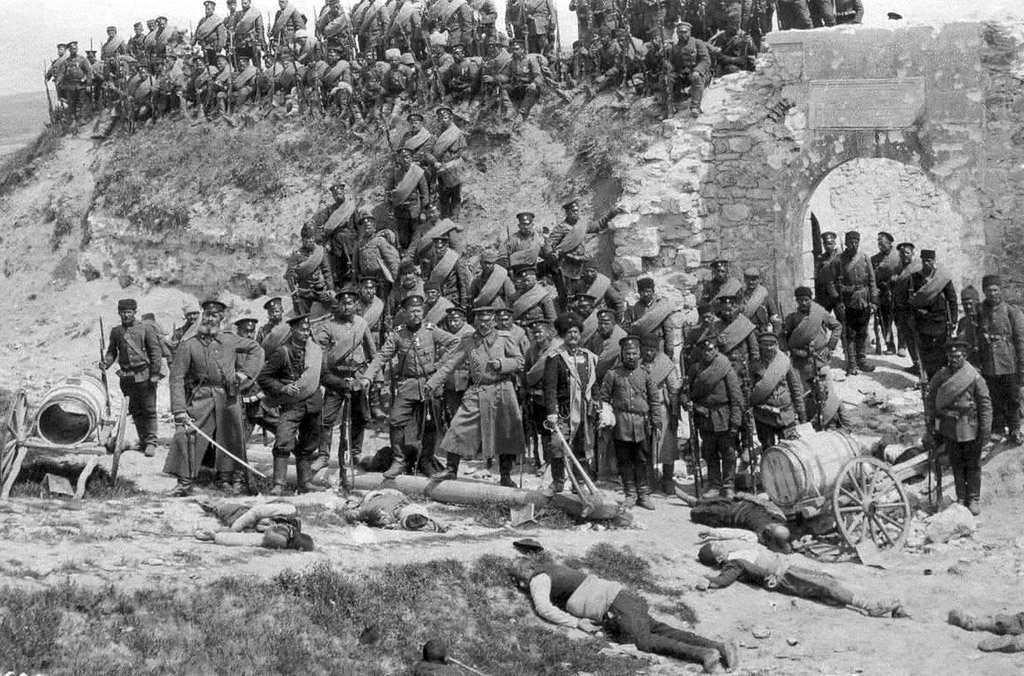
March 1913 - Bulgarian soldiers
(and Turkish dead)
at the Awaz Baba Fort outside Adrianople (Edirne)
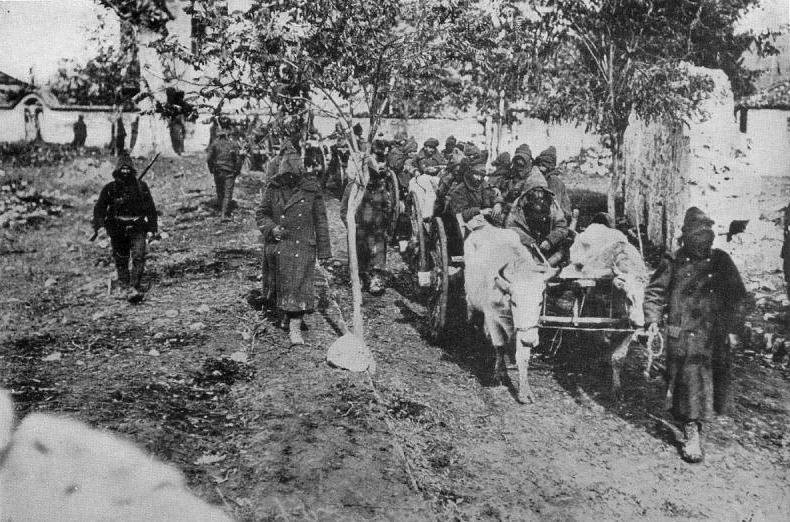 More soldiers died of disease
than through military action
More soldiers died of disease
than through military action
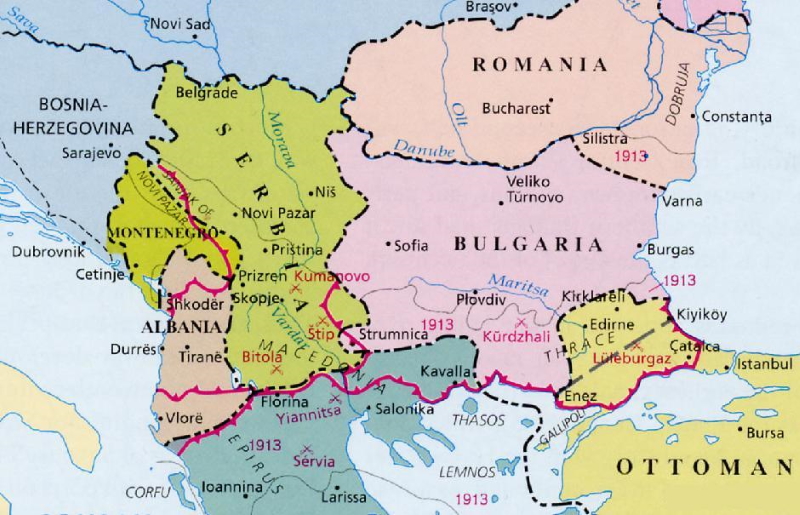 Territorial changes in the
Balkans due to the 2nd Balkans War (April-July 1913)
Territorial changes in the
Balkans due to the 2nd Balkans War (April-July 1913)
GROWING TENSIONS AMONG THE MAJOR EUROPEAN POWERS |
The
age of imperialism had conveniently served to direct rising national
ambitions infecting the European continent away from Europe
itself. But with the near completion of the global land grab by
the end of the 1800s it was perhaps inevitable that these European
ambitions would turn to a question closer to home: the breakup of the
Ottoman Empire and the territories it would free up for the
taking. This matter was too close to home to keep it rather
abstract in principle. With this contest right in its back yard
the danger of this turning into a brawl within Europe itself was
great. It would require great diplomatic skill to prevent this
contest from getting out of hand. But sadly, such skill was
largely missing among those who led these European major powers.
The growing system of opposing alliances
The nationalist passions were heating up. The French had been
unrelentingly bitter about their loss to Germany of Alsace and Lorraine
in the 1870 Franco-Prussian War. To the French it was a matter of
huge principle to get these lands back. Sensing the danger, in
1872 Bismarck promoted the creation of the Dreikaiserbund
(Alliance of Three Emperors) made up of Germany, Russia and Austria as
a counter to French ambitions. But when Russia and
Austria-Hungary found themselves in opposition over the breakup of the
Ottoman Empire, Bismarck decided to drop Russia and stay with his
fellow German Austria. Thus in 1879 he formed the Dual Alliance
between Germany and Austria-Hungary ... and in 1882 he extended this
alliance to include Italy, giving the alliance now the designation as
the Triple Alliance. Italy was not a particularly enthusiastic
partner. But necessity (Italy was fuming over the French seizure
of Tunisia) seem to dictate the relationship.
In the meantime relations between France and Russia were warming up ...
mostly out of concern over the buildup of German military power and the
growth of Austria-Hungary’s interests in the Balkans. By the
1890s this French-Russian relationship had turned itself into a basic
understanding or entente, including the plans for military
cooperation. Basically the entente was an agreement that if
either France or Russia were attacked by a member of the Triple
Alliance, the other would come to the aid of its partner.
At first the British found themselves caught in the middle of this
growing split. Britain approached the alliance matter
cautiously. But concern by both Britain and Japan over Russian
involvement in Asia brought Britain to sign an alliance with Japan in
1902. Then as Wilhelm grew bolder in his development of the
German navy, British nerves began to fray ... and the British decided
to enter into an anti-German entente with their long-time former
opponent, the French, resulting in the Entente Cordiale of 1904.
Finally, with Russia’s defeat in the Russo-Japanese War, the British
concern for Russian activities in Asia dwindled to the point that
Britain was willing to enter yet another entente, this time with
Russia. Thus in 1907 the Triple Entente of Britain, France and
Russia entered into effect. Three years later the Japanese and
Russians came to an agreement ... and Japan thus decided to ally with
the Triple Entente.
The first Moroccan crisis (1905-1906)
Rising
tensions among the European players of the nationalist game nearly
turned to blows exchanged between Germany on the one hand and France
and Spain (backed by Britain) on the other over the status of
still-independent Morocco. Actually, Morocco's independence came
in the form of "protection" offered by France and Spain to Morocco in
1905 … done without any "consultation" with Germany … ignoring an
earlier 1881 agreement which had included Germany as one of the
guarantors of the Moroccan status quo. Wilhelm was not only
insulted that Germany had been left out of the new arrangement … but
was seeing all this as simply another effort of France and its ally
Britain to keep Germany from its natural "place in the sun." Thus
in 1905, Wilhelm personally sailed to Morocco to offer the Moroccan
sultan the same "protection."
A huge diplomatic crisis thus resulted. To avoid a mounting
confrontation, it was finally decided to bring the matter early the
next year (1906) to an international conference held at Algeciras in
Spain (attended also by the U.S. President Teddy Roosevelt). The
conference confirmed the sovereignty of Morocco, but in fact allowed
for both Spain and France (not Germany) to serve as the protectors of
that sovereignty. Germany was still excluded from a role there.
Bosnia-Herzegovina (1908)
As
tensions built in the Mediterranean, without any warning things
exploded over on the other side of Europe … when in 1908
Austria-Hungary simply announced the annexation of the former Turkish
territory of Bosnia-Herzegovina. But land-locked Serbia had also
been contemplating the same action … in order to extend its own borders
all the way to the Adriatic Sea (part of the Mediterranean Sea).
Serbia was furious.
But this land grab also widened the divide between Austria and Russia
(the latter being a strong supporter of Serbia), caused some
consternation with Austria’s ally Germany (which had not been consulted
prior to the event), and forced France and Britain (both neither in a
position to help Serbia nor willing yet to help Russia) to stand off,
very unhappy over the event. And as for Turkey, it was rather
content to receive monetary compensation from Austria for its loss of
these two distant provinces.
The second Moroccan crisis (1911)
Morocco
was not doing well under French and Spanish protection. The
sultan’s finances were in crisis mode and unrest among the Moroccans
was building. When rebellion broke out in Fez against the Sultan
in April of 1911, the French moved troops to Morocco to "protect its
citizens in Morocco" and to support the Sultan. This upset
Wilhelm greatly, who saw this as simply a ploy for the French to add
Morocco to their North African empire. Wilhelm countered the
French move by sending the German gunboat Panther to Morocco "to
protect German citizens."
This in turn angered deeply the French and Spanish ... and also the
British who were lining up more closely with France (the "Entente
Cordiale"). Consequently, France (with British backing) refused
to be intimidated. Ultimately, Wilhelm backed down.
Part of the dynamic in this incident was that Germany had been
challenging British supremacy with its rapid own development of a
German navy, increasing British nervousness about Wilhelm's
intentions. Britain, being an island, was always very sensitive
about international naval matters.
On the other hand, Wilhelm, in being forced to back down from his
ambitions in the Mediterranean, chose to see this episode as simply
more German "encirclement" ... and began looking to expand Germany's
own diplomatic alignments to counter the close relationship of Britain,
France and Spain.
Thus
it was that things were pushing quickly toward the horrible events of
1914. Nationalists of all the major European countries seemed to
want a street fight of some kind to finally settle the matter of
Europe’s power alignment. But what they failed to realize was
that such a fight was not destined to be merely an afternoon sporting
event. The powers seemed so evenly balanced at this point that
once underway such a conflict would simply stalemate itself into a
long, unrelenting bloodletting – the kind that could result only in a
huge loss of political strength by all parties, the kind that would in
the end (should there ever be an end) resolve nothing. But
passions at this point had greatly overridden cool logic.
A war now seemed inevitable.
|
The First Moroccan Crisis – 1905
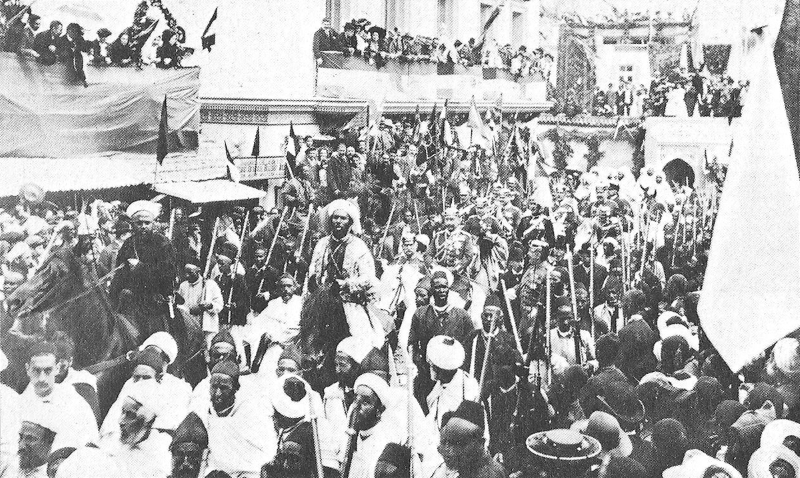
Kaiser Wilhelm on parade in Tangier - 1905

El-Hadj el-Mokri, Moroccan Ambassador
to Spain, signs the treaty at the Algeciras Conference allowing France to patrol
the border with Algeria and Spain to police Morocco (April 7, 1906).
The Agadir (or Second Moroccan) Crisis
- 1911
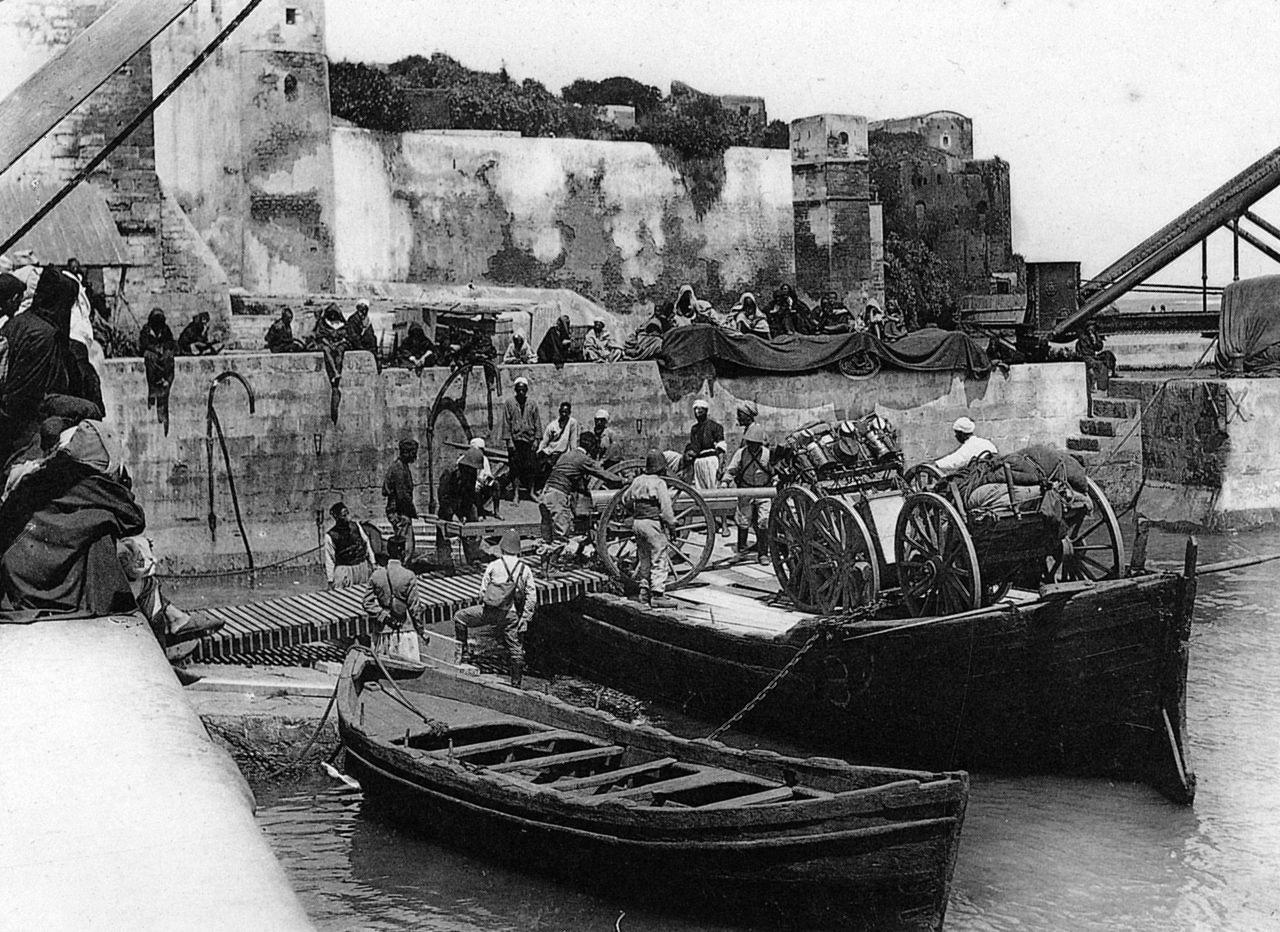
Loading of French artillery
at Rabat, Morocco - 1911
Grébert, photographer,
Casablanca
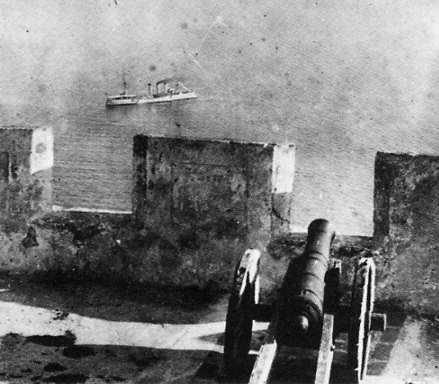 The battlements at Agadir
Morocco - with a German gunboat Panther in the harbor (July
1911)
The battlements at Agadir
Morocco - with a German gunboat Panther in the harbor (July
1911)
WAR FEVER REFUSES TO COOL DOWN |
War
fever seemed to be intensifying everywhere. Nationalists of all
the major European countries seemed to want a street fight of some kind
to finally settle the matter of Europe’s power alignment.
But what they failed to realize was that such a fight was not destined
to be merely an afternoon sporting event. The powers seemed so
evenly balanced at this point that once underway such a conflict would
simply stalemate itself into a long, unrelenting bloodletting – the
kind that could result only in a huge loss of political strength by all
parties ... the kind that would in the end (should there ever be an
end) resolve nothing. But passions at this point had greatly
overridden cool logic.
A war now seemed inevitable.
|
 Miles
H. Hodges Miles
H. Hodges
| |


 The path to world war
The path to world war
 The Balkan Wars as prelude to the
The Balkan Wars as prelude to the Growing tensions among the majo
Growing tensions among the majo War fever refuses to cool down
War fever refuses to cool down








































